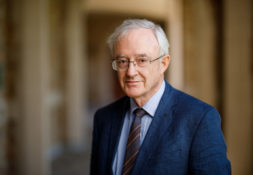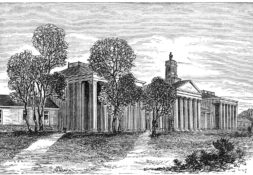Robert Rodes, Faculty Contributor
Professors Amy and Leon Kass, introducing their book of readings on courtship and marriage, Wing to Wing, Oar to Oar, complain of the lack of “a cultural script whose denouement is marriage.”
This dearth gives another dimension to the failure pointed out by Madeline Gillen in the March 21, 2013 issue of the Irish Rover, when she says: “Noticeably lacking in a Notre Dame undergraduate education—the education of the mind and the heart—is any introduction or exposure to the beauty of the Church’s teachings on sexuality…,” and by Michael Bradley in the August 29, 2012 issue, when he complains of Notre Dame administrators failing to bear witness that “The Church wants every man and woman to experience the joys of living a chaste integrated love.” It is certainly true that the Church’s teachings on sexuality should be more effectively presented here, but effective, even insistent, presentation of the teachings will not be enough. Without the cultural script—without an understanding of chaste courtship as a foundation for Christian marriage—the teachings will be floating in a vacuum.
Within living memory—mine, actually—there was such a script in place, and most of my contemporaries courted and married by it. It originated with the Courtly Love poets of the twelfth century, and was carried forward through late medieval romances into Spenser’s The Faerie Queene, Shakespeare’s comedies, nineteenth-century novels and twentieth-century movies until the demise of the Production Code. It fit in nicely with developments in the theology of marriage by such authors as Dietrich von Hildebrand (1889-1977), author of Man and Woman and Marriage—the Mystery of Faithful Love, which should be required reading.
The combination of literary tradition and theological development gave two main themes to the process of Christian courtship. First, it recognized the process as one of both moral and spiritual growth, with lovers learning to pursue their object by striving to become worthy of it. Second, it separated the erotic—the unique attraction that draws lovers to one another—from the merely physical. The difference between the sexes is metaphysical (meta = beyond) before it is physical; so, in the tradition, is the attraction between them. In von Hildebrand’s words:
“Above all, ‘being in love,’ even in its superficial form, must never be confused with sexual desire. Being in love always implies a respectful, chivalrous attitude toward the the Beloved, a certain element of humility even, a melting of the soul, of the rigidity of the Ego. A person truly in love becomes tender and even pure.”
This love emerges from an intuition of the metaphysical complementarity of the sexes, and of one’s own incompleteness in the face of that complementarity. To be truly in love is to recognize a particular person as embodying that complementarity. From that recognition comes the aspiration to a permanent and fruitful union with the person one loves. The sex act of that union is the divinely appointed sign, and other uses of the sex act are wrong because they debase that sign.
A pattern of Christian courtship has been developed in the literature of eight or nine centuries in response to this intuition, recognition and aspiration. Many different kinds of stories follow the pattern, but one way or another, they all seem to involve a man courting a woman. There is a pervasive metaphor of the woman as a walled garden to which the man seeks entrance because the woman has shown herself worthy of being sought after. He gains passage by showing himself worthy of being admitted.
In a time of gender equality, the question naturally arises: Why shouldn’t the woman be courting the man? Why shouldn’t the man be a walled garden with the woman seeking admittance? A short answer is that such a story would be counterintuitive. But it is hard to explain the intuition without falling into objectionable gender stereotypes. The best I can do on the basis of my own experience and shreds of anecdotal evidence is to say that a woman tends to have a more stable, more reflective, more profound interior life than a man has. A man gains access to that life only if she permits him, and that admittance will allow him to gain a more profound understanding of the world. In a lovely poem, “Love in the Valley,” by George Meredith, the speaker says of his beloved, “She is what my heart first awaking whispered the world was.” In stories, and in reality if it is well-lived, a man must prove himself worthy of accessing this deeper understanding.
The usual courtship narrative ends with marriage, so we have little in the tradition to tell us how the woman’s interior life is affected by her acceptance of a man within it. What evidence there is suggests that it will be more focused, more ready to affect the world. Elizabeth Barrett Browning, using the garden metaphor, says in one of her sonnets to Robert: “Indeed, those beds and flowers/ Be overgrown with weeds and rue/ And wait thy weeding.” Marrying Robert transformed Barrett Browning from a couched invalid to a leading poet of the Italian Risorgimento.
So what does all this mean to Notre Dame as a Christian community? Gillen said in her article that, according to a survey, “Notre Dame students shift from 22 percent approval of fornication to 36 percent in their four years at ND.” The statistic is disconcerting, but if it is true, 64 percent of the students continue to believe in chaste courtship and faithful marriage. In the public discourse of our community, we hear surprisingly little from that 64 percent. Perhaps if we had in place the cultural script provided by our traditional love literature, we might hear more.
It is hard to know how to go about inculcating a cultural script. But the literature is there; one can begin by reading it and encouraging others to read it. One can explore it also with the expectation that the archetype will one day be one’s own. People in my generation anticipated that, and for most of us, it was fulfilled. With that expectation, one can see that the Church’s sexual teachings are not the mere academic reflections of medieval celibates: they are for most people the key to less superficial lives.
Robert E. Rodes, Jr. is Paul J. Schierl/Fort Howard Corporation Professor of Legal Ethics in the Law School. He and his wife, Jeanne, who taught many years in the English Department at St. Mary’s, have just celebrated their sixtieth wedding anniversary. They met in a college French class.






Leave a Reply